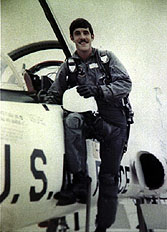Naming the Vietnam Unkown
Michael Joseph Blassie Comes Home
MICHAEL J. BLASSIE, First Lieutenant, USAF
Michael Joseph Blassie entered the Air Force Academy in 1966 and received his officer's commission in June 1970. During his tour of duty in Vietnam, he served as a member of the 8th Special Operations Squadron. He served with distinction and was awarded the Silver Star, the Distinguished Flying Cross, and the Air Medal with 4 Oak Leaf Clusters for his meritorious service. At age 24, his service to his country ended when on May 11, 1972 his A-37B Dragonfly aircraft was shot down near An Loc, South Vietnam.
Five months later a South Vietnamese Army patrol recovered a pelvis, upper arm bone, and some ribs as well as associated physical evidence including the remnants of a flight suit, a life raft, pieces of a parachute, and part of an USAF holster. The remains, along with the associated materials, were eventually turned over to the U.S. Army Central Identification Laboratory, Hawaii (CILHI) for analysis and identification. Given the physical evidence associated with the human remains, they were initially designated "Believed To Be" (BTB) Lt Blassie. However, scientific analysis suggested that the remains were not a compelling match to Blassie's age and height, and some data of unknown origin suggested that the remains could not be Lt Blassie. With the conflicting information between the forensic analysis and the physical evidence, there was no alternative but to designate the remains as "Unknown." They were assigned the number X-26.
In 1984, in an effort to honor all who served in Vietnam, X-26 was selected as the Vietnam Unknown Soldier and buried with military honors in the Tomb of the Unknowns at the Arlington National Cemetery.
Looking for Answers: Mitochondrial DNA Testing
DNA is the chemical compound that transmits genetic information from generation to generation. The DNA molecule is a long, double-stranded chain that is twisted into a spiral-staircase-like structure - the double helix. The handrails of the staircase are composed of linked sugar residues, and each stair is constructed out of two bases held together by hydrogen bonds. Because the sequence of the paired bases is unique to each person, DNA is known as our genetic "fingerprint." Two copies of DNA, one inherited from our mother and one from our father, are stored in the nucleus of our cells. These are called nuclear DNA. DNA is also stored in tiny, energy producing structures in our cells called mitochondria. Mitochondrial DNA (mtDNA) is different from nuclear DNA because we inherit mtDNA solely from our mother and share this genetic information with all our siblings and maternal relatives. Also, unlike nuclear DNA, each cell carries more than a hundred copies of mtDNA since each cell contains many mitochondria but only one nucleus. These characteristics of mtDNA make it a valuable tool in the search for the identity of unknown human remains.




